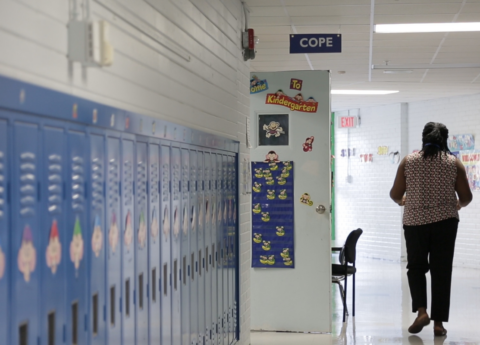In recent years, there has been a lot of debate over the value and role of for-profit colleges. Enrollment at these schools across the country has grown rapidly, but many for-profits have come under scrutiny for poor student outcomes—including alumni having greater debt and lower employment rates than those who attended non-profit schools—as well as deceptive marketing practices. Meanwhile many of these for-profit colleges receive large amounts of federal and state financial aid. Some states are working to require greater accountability from for-profits—including by disqualifying schools with very high student loan default rates from receiving state financial aid.
Here in Kentucky, the Attorney General has been involved in at least nine lawsuits or investigations against for-profit schools. In a national survey of investigations and lawsuits against for-profit colleges between 2004 and 2014, only Massachusetts had more. The lawsuits against for-profits in Kentucky deal with allegations that for-profit schools operating in the state misled students about their financial aid, transferability of credits, and/or job placement numbers to prospective students in marketing materials, among other contentions.
At the same time, $8.6 million in state scholarships went to for-profit colleges in Kentucky in 2012—with the colleges involved in the lawsuits and investigations receiving substantial state funds.
In 2012 Kentucky made a move to improve state oversight of for-profit schools by replacing its State Board of Proprietary Education—which consisted of 11 members, six of whom were employees of the state’s for-profit institutions—with the Kentucky Commission on Proprietary Education—which allows just four of the 11 members to be from for-profit colleges. This change was, among other reasons, to address the board’s improper handling of student complaints. The commission is also tasked with reviewing for-profit schools’ marketing materials and overseeing a student protection fund to pay off debts incurred by students due to the closing of a school.
However, a stronger version of this legislation to eliminate the State Board of Proprietary Education was proposed in 2011—and would have moved the oversight of the state’s proprietary schools to the Council on Postsecondary Education, which oversees the state’s public universities and community colleges. But that proposal was met with strong opposition from proprietary institutions and their lobbying efforts.
Poor Student Outcomes
For-profit colleges tend to serve predominately poor and minority students, often employ overly aggressive and sometimes fraudulent marketing techniques, and typically have tuition rates that are much higher than at public postsecondary institutions. These schools may offer students access to coursework in an accelerated format, among other flexible options, but overall outcomes after graduation are not impressive. While certainly not all for-profit colleges take advantage of students, there is a lot of concern about what students are getting for their money.
A recent report “Profiting Higher Education?,” includes data on how current students and alumni of for-profit colleges feel about their education. While current undergraduates at for-profits are generally happy with their programs and remain optimistic that college will pay off in the long-run with better job opportunities and higher incomes, for those who graduated from these colleges just over a third (37 percent) say getting their degree was well worth it. Another third (32 percent) say that it was not worth it, and 30 percent say that it remains to be seen.
Research by two Harvard professors shows that students who attend for-profit colleges are more likely to have higher levels of debt and more likely to default on student loans than those at other institutions. Students attending for-profit colleges are also more likely to be unemployed and have lower earnings once they leave school than those in community colleges and other “nonselective institutions.” For instance, the researchers found that students from for-profit health programs are more than twice as likely as students from community college programs to be unemployed (19 versus 9 percent), and those that are employed have about 12 percent lower earnings.
Of U.S. students attending for-profit schools scheduled to begin repaying federal student loans in 2011, 21.8 percent defaulted within three years. This is compared to a three-year default rate of 13 percent at public institutions and 8.2 percent at private non-profit schools.
Efforts to Increase Accountability
While there is some federal oversight of for-profit schools—for instance, schools with extremely high student loan default rates and high default rates for several consecutive years face the loss of eligibility in federal student aid programs—some states are working to require additional accountability for for-profit postsecondary institutions.
In 2011 California disqualified from the state’s generous Cal Grant scholarship program schools with three-year student loan default rates above 24.5 percent. As a result, 76 colleges no longer qualified for the state scholarship, 67 of which were for-profits. The cut-off default rate was lowered the following year to 15.5 percent, alongside additional restrictions. Meanwhile, Michigan and Maryland do not allow state financial aid to be used at any for-profit colleges.
A few states have set minimum performance standards that schools must meet as a condition of state approval to operate. For instance, Tennessee sets a minimum job placement rate of 67 percent and a minimum degree completion rate of 75 percent.
Another option for states is to increase public understanding about for-profit colleges. New York state has implemented “Know Before You Enroll,” a public awareness education campaign that encourages prospective students to make informed choices about higher education through marketing materials, on-line resources, free review of enrollment contracts and loan applications, and by collecting complaints about predatory schools. The campaign highlights abuses at for-profit schools and encourages students to thoroughly research education and training programs before enrolling, explore free and low-cost education options, and be careful about taking on a large amount of student debt.
In a similar vein, Research for Action in Philadelphia has received a grant from The Kresge Foundation to develop a state report-card system to grade for-profit colleges and give regulators and consumers more information about the effectiveness and value of these education opportunities. These approaches may prove important as the “Profiting Higher Education?” report found that most students who enroll in for-profit schools do not know much about other education and training options.
These state efforts raise questions about how Kentucky might require greater accountability by the for-profit institutions that enroll thousands of Kentuckians and receive millions of dollars in state financial aid each year.



